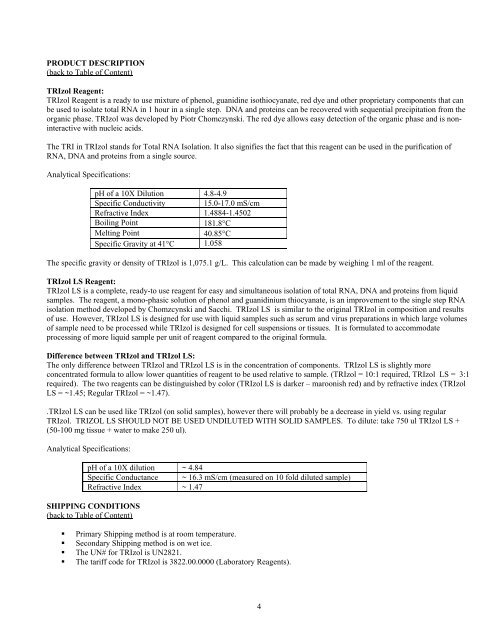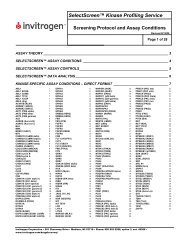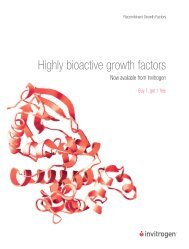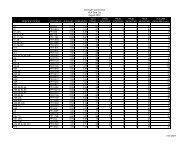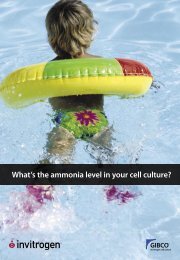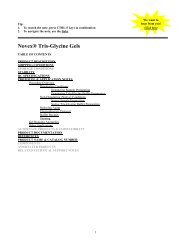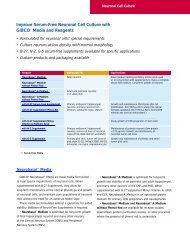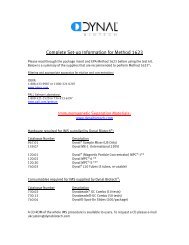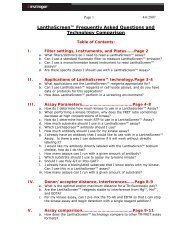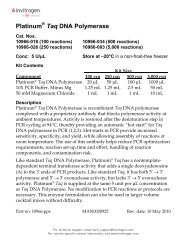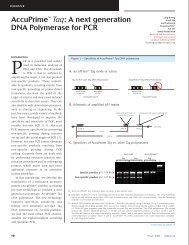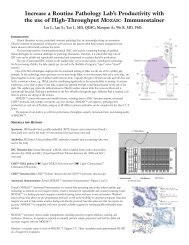TRIzol Reagent - Invitrogen
TRIzol Reagent - Invitrogen
TRIzol Reagent - Invitrogen
You also want an ePaper? Increase the reach of your titles
YUMPU automatically turns print PDFs into web optimized ePapers that Google loves.
PRODUCT DESCRIPTION<br />
(back to Table of Content)<br />
<strong>TRIzol</strong> <strong>Reagent</strong>:<br />
<strong>TRIzol</strong> <strong>Reagent</strong> is a ready to use mixture of phenol, guanidine isothiocyanate, red dye and other proprietary components that can<br />
be used to isolate total RNA in 1 hour in a single step. DNA and proteins can be recovered with sequential precipitation from the<br />
organic phase. <strong>TRIzol</strong> was developed by Piotr Chomczynski. The red dye allows easy detection of the organic phase and is noninteractive<br />
with nucleic acids.<br />
The TRI in <strong>TRIzol</strong> stands for Total RNA Isolation. It also signifies the fact that this reagent can be used in the purification of<br />
RNA, DNA and proteins from a single source.<br />
Analytical Specifications:<br />
pH of a 10X Dilution 4.8-4.9<br />
Specific Conductivity 15.0-17.0 mS/cm<br />
Refractive Index 1.4884-1.4502<br />
Boiling Point 181.8°C<br />
Melting Point 40.85°C<br />
Specific Gravity at 41°C 1.058<br />
The specific gravity or density of <strong>TRIzol</strong> is 1,075.1 g/L. This calculation can be made by weighing 1 ml of the reagent.<br />
<strong>TRIzol</strong> LS <strong>Reagent</strong>:<br />
<strong>TRIzol</strong> LS is a complete, ready-to use reagent for easy and simultaneous isolation of total RNA, DNA and proteins from liquid<br />
samples. The reagent, a mono-phasic solution of phenol and guanidinium thiocyanate, is an improvement to the single step RNA<br />
isolation method developed by Chomzcynski and Sacchi. <strong>TRIzol</strong> LS is similar to the original <strong>TRIzol</strong> in composition and results<br />
of use. However, <strong>TRIzol</strong> LS is designed for use with liquid samples such as serum and virus preparations in which large volumes<br />
of sample need to be processed while <strong>TRIzol</strong> is designed for cell suspensions or tissues. It is formulated to accommodate<br />
processing of more liquid sample per unit of reagent compared to the original formula.<br />
Difference between <strong>TRIzol</strong> and <strong>TRIzol</strong> LS:<br />
The only difference between <strong>TRIzol</strong> and <strong>TRIzol</strong> LS is in the concentration of components. <strong>TRIzol</strong> LS is slightly more<br />
concentrated formula to allow lower quantities of reagent to be used relative to sample. (<strong>TRIzol</strong> = 10:1 required, <strong>TRIzol</strong> LS = 3:1<br />
required). The two reagents can be distinguished by color (<strong>TRIzol</strong> LS is darker – maroonish red) and by refractive index (<strong>TRIzol</strong><br />
LS = ~1.45; Regular <strong>TRIzol</strong> = ~1.47).<br />
.<strong>TRIzol</strong> LS can be used like <strong>TRIzol</strong> (on solid samples), however there will probably be a decrease in yield vs. using regular<br />
<strong>TRIzol</strong>. TRIZOL LS SHOULD NOT BE USED UNDILUTED WITH SOLID SAMPLES. To dilute: take 750 ul <strong>TRIzol</strong> LS +<br />
(50-100 mg tissue + water to make 250 ul).<br />
Analytical Specifications:<br />
pH of a 10X dilution ~ 4.84<br />
Specific Conductance ~ 16.3 mS/cm (measured on 10 fold diluted sample)<br />
Refractive Index ~ 1.47<br />
SHIPPING CONDITIONS<br />
(back to Table of Content)<br />
Primary Shipping method is at room temperature.<br />
Secondary Shipping method is on wet ice.<br />
The UN# for <strong>TRIzol</strong> is UN2821.<br />
The tariff code for <strong>TRIzol</strong> is 3822.00.0000 (Laboratory <strong>Reagent</strong>s).<br />
4


